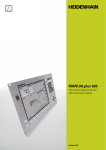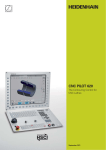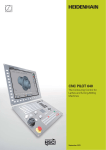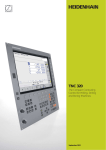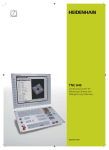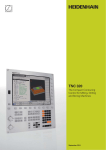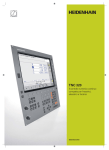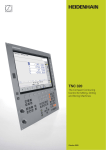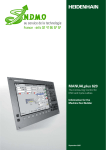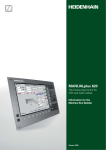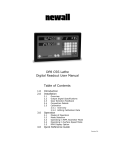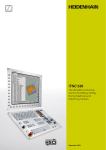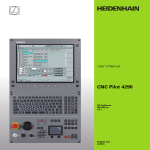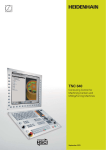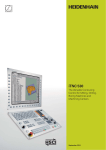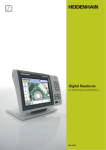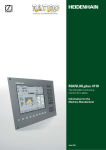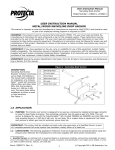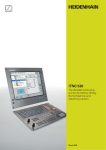Download MANUALplus 620
Transcript
MANUALplus 620
The Contouring Control for
CNC and Cycle Lathes
September 2012
Start smart
For many years now, the MANUALplus has
been proving itself in daily use on cycle
lathes and has earned a reputation for convenient manual machine operation. Application-oriented cycle programming enables
the machinist to create and edit programs
rapidly and efficiently on the lathe. The introduction of the MANUALplus 620 extends the area of application to single-spindle CNC lathes. With the smart.Turn
operating mode, HEIDENHAIN has made
yet another step forward toward greater
ease of use. Easily understandable program entry in forms, default setting for
global values, numerous selections and
straightforward graphic support ensure fast
and easy operation.
The new smart.Turn interface is based on
the proven HEIDENHAIN-DIN PLUS. Because smart.Turn produces DIN PLUS pro-
This brochure describes the functions and specifications of the MANUALplus 620 with NC software 54843x-01.
2
grams. It provides both the NC programmer and the machine operator with all
relevant information during program run.
Contents
The MANUALplus 620...
Where can it be used?
4
Compact and versatile
– MANUALplus 620, the control for CNC and cycle lathes
What does it look like?
6
Well designed and user friendly
– The MANUALplus 620 in dialog with the user
What can it do?
8
Universally applicable
– The right programming mode for every task
10
Easy machining with cycles
– Preprogrammed machining steps
– From single parts to series
14
Well thought out, simple and flexible
– Simple programming with smart.Turn
– NC program at the push of a button with TURN PLUS
18
Describing and importing contours
– ICP interactive contour programming
20
Realistic testing before machining
– Graphic simulation
22
Expandable for complex tasks
– Full-surface machining including the C axis and Y axis
– Turning, drilling and milling in one setup
– Working in a tilted plane with the B axis
28
Fast availability of tool data and cutting data
– MANUALplus tool database and technology database
30
Workpiece measurement
– Setup, presetting and measuring with touch trigger probes
31
Tool measurement
– Measuring length, radius and wear directly in the machine
32
Open for communication
–
–
–
–
... At a glance
Fast data transfer with the MANUALplus 620
Display any file formats on the control screen
The DataPilot MP 620 programming station
Fast availability of all information
36
Overview
–
–
–
–
User functions
Options
Accessories
Specifications
3
Compact and versatile
– MANUALplus 620, the control for CNC and cycle lathes
Thanks to its flexible design and numerous
programming features, MANUALplus 620
always gives you optimum support. Regardless of whether you are manufacturing
single parts or batches, simple or complex
workpieces, the control always adapts to
the needs of your company. The
MANUALplus 620 is characterized by its
simple operation and programming. It is
quickly learned and requires minimum
training time.
The MANUALplus 620 was conceived both
for CNC and cycle lathes. It is suitable for
horizontal and vertical lathes. The
MANUALplus supports lathes with simple
tool holders and lathes with tool turrets.
The tool carrier of horizontal lathes can be
located in front of or behind the workpiece.
The MANUALplus supports lathes with
spindle, one slide (X and Z axis), C axis or
positionable spindle, driven tools and machines with a Y axis and B axis.
MANUALplus 620 for cycle lathes
On the MANUALplus 620, rework or simple tasks can be done in the same way as
on a conventional lathe. You move the axes
in the normal manner by turning the handwheels. For difficult cuts like tapers, undercuts or threads, the cycles of the
MANUALplus are available.
For small and medium-size production
runs, cycle programming will increase your
revenue. When machining the first workpiece, you can store the machining cycles,
and already save valuable time when machining the second workpiece.
For increased requirements and complex
machining tasks, you will profit from the
new programming mode smart.Turn.
MANUALplus 620 on a cycle lathe
4
MANUALplus 620 for CNC lathes
Regardless of whether you are turning simple parts or complex workpieces, the
MANUALplus 620 provides you with the
benefits of graphical contour input and convenient programming with smart.Turn.
Programming with variables, controlling
special machine components, or using externally created programs, etc. is no problem: simply switch to DIN PLUS. This programming mode helps you solve all your
special tasks.
MANUALplus 620 on a CNC lathe
5
Well designed and user friendly
– The MANUALplus 620 in dialog with the user
The screen
The 12.1-inch TFT color flat-panel display
shows a clear overview of all relevant information for programming, operating and inspecting the machine tool and control such
as program blocks, comments and error
messages.
During program input the required parameters are illustrated in help graphics, and
during test run the MANUALplus simulates
the cutting process on the screen. During
program run the screen displays information on the tool position, the rotational
speed, the feed rate and the utilization of
the drives as well as further information on
the machine status.
The positions of the tool are shown in large
characters. The respective distance-to-go,
the feed rate, the spindle speed and the ID
number of the current tool are also clearly
visible. A moving-bar diagram shows the
current utilization of the spindle and the
axis drives.
The keyboard
The MANUALplus needs very few keys.
Easily understood symbols clearly indicate
the functions.
The keys on the numeric keypad are used
both for data input and for selecting the
functions. The menu window displays the
available functions graphically. The function
keys below the screen are used to modify
the selected functions, assume position
and technology values, and control the data
input.
The machine operating panel
The machine operating panel is designed
by the machine tool builder. Your machine
panel might look like this: handwheels for
saddle and cross slide, joystick for continuous axis movement, rotary switch for the
handwheel transmission ratio, rotary
switch for spindle CCW/CW/stop, buttons
for cycle start/stop and an emergency stop
switch.
6
Operating modes
Display of the machine status. The display is configurable. You can
choose a suitable function for each of the 16 fields, and save different display assignments for the automatic and manual mode.
Straightforward input forms for cycle programming, smart.Turn
programming or DIN PLUS programming. The input parameters
are illustrated in help graphics during NC programming.
Unambiguous function keys for NC programming
PLC function keys for machine components
Operating mode keys
Navigation keys
Special keys
Activate special functions, such as
input options or input of characters
as on a cell phone
Machine operating modes
Programming modes
Tables for tool data and technology
data
Screen/page up/down
Parameters, file management, transfer, diagnostics
Go to beginning of program/
list or to end of program/list
Calculator
Call up messages and errors
Clear error from machine operating
modes
smart keys
Switch to the next detail input
form
Previous/next group
Switch the help graphics between
outside/inside machining (cycle programming)
7
Universally applicable
– The right programming mode for every task
With its different programming operating
modes, cycle programming, smart.Turn
and DIN PLUS, the MANUALplus 620 always gives you optimum support for your
tasks.
Manual
• Simple, non-repetitive machining tasks
• Rework
• Thread repair
Machining with cycles
Define the cycle
±
Simulate the cycle
±
Machine the workpiece
Regardless of whether you want to rework a
workpiece or machine a single part on a cycle
lathe, the cycles of the MANUALplus 620
will simplify your work. For manufacturing
batches, you create a cycle program by
saving the cycles during the machining of
the first workpiece. The effective programming mode smart.Turn for fast and easy
NC program creation helps you take care
of more demanding tasks.
Teach-in
• Manual-oriented machining of small and
medium-size production runs
• Graphic description of complex contours
Machining with cycles
±
Define the cycle
±
Simulate the cycle
±
Machine the workpiece
±
Save the cycle
±
Finished cycle program
8
On CNC lathes, the best method to create
a program is to use smart.Turn. This programming mode from HEIDENHAIN is
based on input forms and allows you to
create structured, easy-to-read NC pro-
smart.Turn
• Convenient smart.Turn programming
• Graphic contour description
• Numerous machining units
• Compatible with cycle programs
grams in which you can even store all setup information needed to machine the
workpiece.
• Clearly structured and easy-to-read
programs
• All required data contained in the
respective working block
If you want to use the variable programming feature or externally created NC programs, or if you have to cope with special
requirements, DIN PLUS will give you optimum support.
DIN PLUS
• Familiar G-code programming
• Graphic contour description
• Numerous fixed cycles
• Variable programming and subprograms
• Resolving smart.Turn units into G-code
commands
• Compatible with externally created DIN
programs
smart.Turn
Create smart.Turn program
±
Simulate smart.Turn program
±
DIN PLUS
External programming
Resolve a smart.Turn unit
Edit the DIN program
Finished smart.Turn program
±
±
±
Simulate the DIN program
±
Finished DIN program
9
Easy machining with cycles (option)
– Preprogrammed machining steps
On the MANUALplus 620, you can use the
handwheel to perform simple operations,
such as turning or facing, just like on any
conventional lathe. Standard machining operations, such as area clearance, slot milling, recess turning, undercutting, parting,
thread cutting, boring, drilling, and milling
are stored in the MANUALplus 620 as cycles. You simply enter the positions, dimensions and specifications, and the control
will automatically run the machining program.
Manual workpiece machining
The MANUALplus 620 simplifies manual
turning with numerous functions, without
requiring you to learn complicated procedures. This enables you, for example, to adjust the feed rate and spindle speed steplessly during machining, to machine with
preset tools or to part with constant cutting
speed during machining.
Workpiece machining with cycles
For simple, non-recurring tasks, reworking,
thread repair or small production runs, the
cycles of the MANUALplus simplify your
work.
Help graphics and dialogs illustrate the few
entries needed for the cycles. Before cutting, use the simulation to assure yourself
that the machining will run as planned.
Thread cutting—three times faster with a cycle
Turn cylinders manually:
You work as usual with the handwheels and the position display on the
screen.
10
Turn tapers automatically:
Just enter the dimensions—the MANUALplus 620 moves the saddle and
cross-slide automatically.
Fewer calculations
The MANUALplus automatically calculates
the number of cuts for roughing, recessing, recess turning or thread cutting, and
for pecking it determines the required number of infeeds. When turning a taper, you
can enter either the starting point and end
point, or the starting point and the taper angle—whichever is shown on your drawing.
Constant availability of tool data
The MANUALplus uses a tool database.
Tool data, such as cutting radius, tool angle
and point angle only have to be entered
once to find the setting dimensions, for example by touch-off. The MANUALplus
saves the data. The next time you use the
tool, you simply call the tool number. The
MANUALplus automatically adjusts for the
correct tool size. You can immediately work
to dimension.
When turning a contour, the MANUALplus
automatically compensates the deviations
due to the cutting-edge radius. This increases the precision of your workpiece.
Technology data as default values
The MANUALplus saves the cutting data
according to the criteria of workpiece material, tool material and machining mode.
As you have already entered the cutting
material in the tool definition, you need
only enter the material of your workpiece.
This provides the cycle with all data required for setting default values for the cutting data.
Reference points
You can define the workpiece datum by
touching the workpiece with the tool or by
entering the datum coordinates.
Approach the tool-change point once and
store this position. Then a simple cycle call
suffices to return to the tool change point.
Protective zone for the spindle
For every tool movement in the negative Z
direction, the MANUALplus checks whether the programmed protective zone would
be violated. If so, it stops the movement
and responds with an error message.
Run a cycle to cut a thread automatically:
Call the appropriate fixed cycle and enter the dimensions. The
MANUALplus 620 performs the operation automatically.
11
Easy machining with cycles (option)
– From single parts to series
The first workpiece
Machine the workpiece cycle for cycle in
the usual way and save the machining
steps. When you have finished machining,
you save the created cycle program, creating the working plan for the workpiece. The
MANUALplus displays the individual machining steps in the proper sequence on
the screen.
Repeating individual cycles
After you have saved the cycles for one
part you can always go back later to edit or
delete the steps used to machine it, or insert new steps.
You can save a great deal of time with the
MANUALplus when using this feature to
produce a family of parts.
Saving your work for the next part
You can store all cycles and rerun them automatically. Each additional part machined
saves you time and cost.
1. Transverse turning
12
2. Longitudinal turning
Cycles for turning
You will always find the appropriate cycle in
the cycle menus of the MANUALplus. Help
graphics and dialogs explain the operation,
all required dimensions and other entries.
After entering these values, you can graphically inspect the cutting process and let the
operation run automatically.
Area clearance—cutting and finishing
Longitudinal/transverse cutting for simple
contours
Longitudinal/transverse cutting with
plunging
Longitudinal/transverse ICP cutting for
any contours
Longitudinal/transverse ICP contour parallel cutting
Threads and undercuts
Single- or multi-start longitudinal,
tapered or API thread
Recessing and recess turning—cutting and finishing
Radial/axial recessing for simple contours
Undercuts as per DIN 76,
DIN 509 E and DIN 509 F
Longitudinal/transverse recess turning
for simple contours
Undercuts and parting
3. Finishing
Undercut form H, form K or
form U
Radial/axial ICP recessing for any
contours
Parting
Longitudinal/transverse ICP recess
turning for any contours
4. Threading with undercut and chamfer
13
Well thought out, simple and flexible
– Simple programming with smart.Turn (option)
Has the safety clearance been correctly entered, is the speed limit taken into account,
how are oversizes defined? All this needs
to be considered not only by the beginner,
but also by the experienced NC programmer when creating conventional DIN programs.
The smart.Turn principle
The working block—called a unit—plays
the central role in smart.Turn programs.
A unit describes a machining step completely and unambiguously. The unit includes the tool call, the technology data,
the cycle call, the approach and departure
strategies as well as global data, such as
safety clearance, etc. All these parameters
are summarized in one, clearly structured
dialog box.
The smart.Turn principle gives you the reassurance that the working block is defined
correctly and completely. In the NC program, smart.Turn lists the DIN PLUS commands of the unit. This gives you an overview of all working-block details at any
time.
14
Programming made simple
With smart.Turn, you program with the aid
of easy-to-use, unambiguous fillable forms.
The overview form shows you a summary
of the selected unit, and subforms provide
information on the details of a working
block. Clearly arranged help graphics illustrate all required input. If input options are
available, smart.Turn displays a list of the
available options for selection.
Global program parameters, such as oversizes, safety clearances, coolants, etc., are
defined once in the start unit. Then smart.
Turn transfers these parameters to the other units.
smart.Turn supports units for roughing, finishing, recessing, recess turning, thread
cutting, boring, drilling, tapping, and milling,
as well as special units for program start,
program end, moving the C axis in/out,
subprograms and program section repeats.
By the way: You do not need to stop the
manufacturing process for programming
with smart.Turn. You can create and test
the smart.Turn program while the program
is running.
Structured and easy-to-read
Clearly structured and easy-to-read—these
are the characteristics of smart.Turn programs. smart.Turn uses section codes that
clearly distinguish between the program
head with setup information, the turret assignment, the workpiece description and
the actual machining operation.
The smart.Turn technique not only ensures
that the program is easy to read, but it also
makes it possible to save all information required for producing the workpiece in the
NC program.
Programming contours
smart.Turn enables you to work simply and
flexibly. Simple contours can be defined
with just a few entries in the cycle. Complex contours are described with ICP interactive graphics. Workpiece descriptions
that are available in DXF format can be easily imported.
Contour follow-up
When you define the workpiece blank,
smart.Turn uses the contour follow-up
function, by which the MANUALplus computes the new blank form after each cut.
The machining cycles are adapted automatically to the current workpiece blank. The
contour follow-up helps you to avoid air
cuts and optimize approach paths, even if
the workpiece material has been previously
removed.
Technology data as default values
The MANUALplus saves the cutting data
according to the criteria of workpiece material, tool material and machining mode.
As you have already entered the cutting
material in the tool definition, you need
only enter the material of your workpiece.
This provides smart.Turn with all data for
setting default values for the cutting data.
Programming in DIN PLUS
smart.Turn offers units for all machining
tasks as well as units for special functions.
If you want to control special machine
components, or use the variable programming function or other complex functions
that are not provided by smart.Turn,
DIN PLUS will support you. It provides
powerful machining cycles, program
branches and programming with variables.
You can switch back and forth between the
smart.Turn and DIN PLUS programming
modes within a program.
Because the units are based on DIN PLUS,
you can break up a unit into blocks at any
time to modify and optimize the resulting
DIN PLUS program section.
Of course the MANUALplus 620 also allows you to create a DIN program, or to import and use externally created programs.
15
Well thought out, simple and flexible
– NC program at the push of a button with TURN PLUS (option)
With TURN PLUS you can create part programs in a very short time. After you have
entered the contour of the blank and finished part, you only need to select the material and clamping devices. TURN PLUS
does everything else automatically: it generates the working plan, selects the machining strategy, selects the tools and cutting data, and generates the NC blocks.
The result is a thoroughly commented
smart.Turn program with units that gives
you room for optimization and ensures
safety when you’re breaking in the program.
TURN PLUS can do all that for milling, drilling and boring operations with the C or Y
axis on face and cylindrical surfaces as well
as on rear-face surfaces in machines with
opposing spindles.
The part program at a keystroke
If short programming times are important
to you, you can generate all machining
steps by pressing a single key. On the basis of the contour entered and the information from the technological database,
TURN PLUS independently prepares the
working plan and chooses suitable machining strategies, tools and cutting data. The
whole operation takes only a few seconds.
You can monitor each individual step in the
control graphics. TURN PLUS uses a reasonable sequence of possible operations,
such as “first roughing transverse, then
roughing longitudinal” or “finishing inside,
then finishing outside.” However, you can
adapt this sequence yourself to specific
tasks, so the MANUALplus also uses your
company’s machining know-how for the automatic generation of working plans.
Go from programming to machining reliably and in the shortest possible time
16
Automatic program generation for fullsurface machining
The MANUALplus automatically generates
the part program even for complex workpieces that need to be machined on the
front face, rear side, and lateral surfaces.
After defining the geometry, this can save
you about 90 % of the time otherwise
needed to create a program.
Automatic program generation for the
second setup
TURN PLUS knows the contour of the
clamping devices when it generates the
working plan. It automatically limits the tool
path to a safe distance from the clamping
device. When the program for the first setup is completed, you can “rechuck” using
interactive graphics. The control then automatically generates the program for the
second setup using the workpiece geometry that has already been entered.
Inclined contours are no problem
The control is presented with special requirements when it has to generate the
part program for inclined contours. Very often the angle of inclination is steeper than
the tool tip angle. In that case the control
automatically chooses another tool and machines the contour in the opposite direction
or as a recess. In any case the result is an
executable part program.
Defining the machining sequence
In the TURN PLUS dialog you can define a
standard machining sequence.
You can save various machining sequences, e.g for chuck parts or shaft machining.
From the global main types of machining,
such as “roughing,” “finishing”, or “drilling,”
to details like defining a tool for a specific
operation—the automatic working plan
generation (AWG) can be adapted to the
user’s requirements.
Automatic selection of
all cycles, tools and
cutting data
17
Describing and importing contours
– ICP interactive contour programming (option)
For jobs that cannot be machined with the
standard cycles because of the complexity
of the workpiece or the lack of certain dimensions in the workpiece drawing, you
need ICP, the interactive contour programming. You describe the contour elements
directly as they appear in the workpiece
drawing. Or—if the drawing is available in
DXF format—you simply import the contour.
Contour programming with ICP
You define an ICP contour by entering the
contour elements one after the other in the
graphic editor. When selecting the contour
elements, you already specify the direction
of the line or the direction of rotation of the
circular arc. This way the MANUALplus
needs very little information about the contour element.
When entering the data, you decide
whether the coordinates are absolute or incremental, and whether you enter the end
point or the length of the line or the center
point or the radius of a circular arc. You also
specify whether the path to the next contour element should be tangential or nontangential.
As long as they are mathematically defined, the MANUALplus calculates missing
coordinates, intersections, center points,
etc. If the entered data permit several
mathematically possible solutions, you can
view the individual solutions and then select the proposal that matches the drawing. You can modify or change existing contours.
18
Superimposing form elements
The ICP editor recognizes the chamfer,
rounding and undercut (DIN 76, DIN 509 E,
DIN 509 F, etc.) form elements. You can enter these form elements in the course of
the sequential contour definition. However,
it is often easier to first define the “rough”
contour, and then to superimpose the form
elements. This is done by selecting the corner on which the form element is to be
placed and then inserting the element.
ICP contours for smart.Turn and
DIN PLUS
In smart.Turn you have various possibilities
for describing the contour to be machined.
You can describe simple contours right in
the unit and use ICP for turning or milling
contours as well as linear or circular drilling
and milling patterns. The contour defined
with ICP is transferred to the smart.Turn
program. In the unit you enter a reference
to the contour section to be machined.
ICP contours for cycle programs
In turning or milling operations, standard
contours are defined in the cycle. Complex
contours are described with ICP and then
called in an ICP roughing, ICP recessing,
ICP recess turning or ICP milling cycle.
If you are working in DIN PLUS mode, you
can also describe the turning and milling
contours, linear and circular patterns with
ICP. In the contour-based cycles you enter
a reference to the contour section to be
machined.
The ICP editor can be called directly during
cycle programming.
10°
9
3
45
0°
35°
°
DIN 76-A
R1
2
4
M20 x 1.5
3
¬ 48
¬ 63
¬ 53
¬ 52
¬ 70
2 x 45°
0
18
36.5
0.5 x 45°
42.5
56
62
79.5
100
0.5 x 45°
DXF import of contours (option)
Why should you painstakingly enter contour elements if the data already exists in
the CAD system? ICP makes it possible to
import contours in DXF format directly into
the MANUALplus 620. Not only does this
save time otherwise spent on programming and testing, but you can also be sure
that the finished contour is exactly according to the designer’s specifications. DXF
contours can describe workpiece blanks,
finished parts, contour trains and milling
contours. They must exist as two-dimensional elements in a separate layer, i.e.
without dimension lines, wrap-around edges, etc.
First, you download the DXF file onto the
MANUALplus over the network or use a
USB stick. Since the DXF format is fundamentally different from the ICP format, the
contour is converted from DXF to ICP format during the import. This contour is then
treated as a normal ICP contour, and is
available for smart.Turn, DIN PLUS or cycle
programming.
19
Realistic testing before machining
– Graphic simulation
Timely detection of errors is very important
for the production or repair of single parts.
With its graphic simulation feature, the
MANUALplus 620 supports you in checking the program for errors—exactly and
with the real dimensions of the contour
and cutting edge.
The wire-frame graphic is suited for a
quick overview of the proportioning of cuts.
The path of the theoretical tool tip, however, is not identical with the contour of the
workpiece. This view is therefore not as
suitable if you wish to run a thorough check
of the machined contour.
Graphic simulation
Before actual machining, you use the
graphic simulation to inspect the
• machining sequence,
• proportioning of cuts,
• and the finished contour.
A more accurate contour verification is provided by the cutting-path graphics. The
cutting-path graphics account for the exact
geometry of the tool tip. You immediately
see if material was left behind, the contour
is damaged or the overlaps are too large.
The cutting-path graphics is especially useful for recessing, drilling and milling operations where the tool shape has an essential
influence on the accuracy of the resulting
workpiece.
In the graphic simulation you can display
the tool cutting edge. You see the cuttingedge radius, the cutting-edge width and
the cutting-edge position with their actual
dimensions. This helps to recognize machining details or collision risks in time.
Wire-frame or cutting-path graphics,
machining simulation
The MANUALplus supports various views
of the tool paths and the machining process. You can choose the type of verification best suited to the tool or machining
process used.
20
The machining simulation (material removal graphic) displays the workpiece
blank from which material is removed.
The blank is displayed as a white surface.
The MANUALplus simulates every tool
movement at the programmed cutting
speed and removes the material.
3-D view
With the 3-D graphics the workpiece blank
and finished part are shown in a solid-model view. You can rotate the graphic about
the principal axes or display it in a sectional
view.
Selecting views
If your lathe is equipped with driven tools
and positionable spindle, a C axis or a
Y axis, the MANUALplus also simulates
machining on the end face and lateral surface, or the XY and YZ plane. You select the
combination of windows best suited to the
job. This gives you everything you need to
closely examine your drilling and milling operations.
The MANUALplus depicts C-axis machining of the cylindrical surface as an “unrolled” plane surface.
Zoom function
Use the “magnifying glass” to set the view
to your current needs: greatly magnified in
order to control the machining details, or
zoomed-out to show the entire workpiece
or current working space in order to get an
overview of the machining process.
Calculating the machining time
If your customer needs an offer in a hurry,
and you need exact information in a very
short time, the MANUALplus is a valuable
aid with its machining time calculator. During simulation of the cycle, smart.Turn or
DIN PLUS program, the MANUALplus calculates the time per piece for the programmed machining.
Along with the total time, the table displays
the machining time and idle time of each
cycle or each tool insert. This assists you
not only in your calculations, but you can
also tell at a glance whether there are
more possibilities for optimization during
the machining process.
21
Expandable for complex tasks
– Full-surface machining including the C axis and Y axis (option)
The MANUALplus 620 provides a solution
for any machining task and any machine
configuration: it performs complex machining tasks with a C or Y axis. It also controls
full-surface cutting on dual-spindle machines.
And for C-axis, Y-axis, and full-surface machining you can select from the DIN PLUS,
smart.Turn or Teach-in programming
modes.
C axis or positionable spindle*
For more complex tasks, the MANUALplus 620 can be expanded to also control a
C axis or positionable spindle and a driven
tool. The driven tool makes it possible to
drill off-center and to tap holes while the
spindle is at rest. The C axis or positionable
spindle permit milling, drilling, and boring
on the face and lateral surface of the workpiece. These elements can be displayed for
programming and verification in face view
and in the unrolled lateral surface view.
Y axis*
With the Y-axis option of the MANUALplus 620 you can machine slots or pockets
with plane bottoms and perpendicular slot
walls. By defining the spindle angle, you
can determine the position of the milling
contours on the workpiece. For programming and verification of these machining
sections, the workpiece is shown in side
and face view. The Y axis is supported in
the smart.Turn and DIN programming feature.
Dual-spindle option
For full-surface lathes, the MANUALplus 620 provides the following features:
• Opposing spindle with second C axis
• Movable tailstock (W axis)
These features are complemented by additional functions such as coordinate transformation, spindle synchronization and traversing to a stop surface.
Coordinate transformation
Contours of workpiece blanks and finished
parts can be mirrored about the X axis or
shifted relative to the workpiece datum.
*
Graphic contour programming for C-axis
machining (milling, drilling and boring)
22
First fixture
The machine and the MANUALplus 620 must be
adapted to this function by the machine tool builder.
Spindle synchronization
Opposing spindles are electronically coupled and rotate synchronously. This makes
it possible to transfer the workpiece from
one spindle to the other while they are rotating, thereby saving the time otherwise
spent braking and starting the spindles. The
MANUALplus 620 detects any angular offset and compensates it during subsequent
milling on the opposing spindle.
Spindle 1 (S1) with C axis (C1) and driven tool (S2)
Traversing to a fixed stop
To ensure that the workpiece is firmly
pressed to the opposite spindle surface,
the control monitors the nominal and actual
positions while the longitudinal axis is moving and thereby detects the fixed stop.
The MANUALplus monitors the motor
torque and uses it to reach the programmed contact force.
Full-surface machining:
Opposing spindle (S3)
with C axis (C2) on
secondary axis (W)
and driven tool (S2)
W
Machining of the rear face on the opposing
spindle after automatic workpiece transfer
23
Expandable for complex tasks
– Turning, drilling and milling in one setup (option)
You can use the MANUALplus 620* to drill
and mill your workpiece on the end face
and lateral surface in one setup with numerous functions and proven cycles.
* Optional. The machine and the MANUALplus 620
must be adapted to this function by the machine tool
builder.
Drilling, deep-hole drilling, tapping
The MANUALplus drills, pecks and taps individual holes with the C or Y axis. Via parameters you can easily program infeed reductions for the beginning of drilling or
when drilling completely through the workpiece.
Drilling and milling patterns
If bore holes, slots or ICP milling cycles are
located at regular distances on a straight
line or a circular arc, the MANUALplus
greatly simplifies your work: You can create
these patterns on the end face or lateral
surface with just a few key strokes.
Thread milling
On lathes equipped with a C or Y axis, you
can take advantage of thread-milling, because the MANUALplus supports special
thread-milling tools.
Milling slots and simple figures
Slot milling with the MANUALplus is very
simple. You define the position and depth
of the slot as well as the cutting values—
the milling cycles automatically take care of
the rest.
Even for simple contours such as circles,
rectangles and equilateral polygons, just a
few keystrokes are necessary to determine
the figure and position.
Drilling
Deep-hole drilling
Tapping
Thread milling
Drilling or tapping
24
Cycles for drilling
Contour and pocket milling
The milling cycles of the MANUALplus
support contour and pocket milling. You determine all the important details, such as
machining direction, milling direction, approach and departure behavior, infeeds,
etc. The MANUALplus automatically compensates for the tool radius.
You can mill the pocket in two stages—first
roughing, and then finishing. The result is
high accuracy and good surface quality.
In smart.Turn and DIN programming, the
MANUALplus 620 supports various infeed
strategies. You can choose between direct,
reciprocating, or helical infeed, or infeed at
the predrilling position.
Face milling
The face milling cycle machines individual
surfaces, equilateral polygons or a circle—
even off-center.
Engraving cycles
Do you want to “inscribe” your workpieces? That’s no problem with the MANUALplus 620. The smart.Turn units for engraving only need a few parameters to engrave
characters of any size on a face or lateral
surface, or on the XY or YZ plane.
On the workpiece face you can arrange the
characters on a line or an arc. On the lateral
surface, and when engraving with the
Y axis, you define the angle at which the
characters are to be arranged
Of course, the engraving cycles are also
available as DIN PLUS cycles.
Deburring
The MANUALplus supports special units or
DIN PLUS cycles for deburring. You enjoy
the benefit of being able to program this
operation with only a few parameters.
Helical slot milling
The helical-slot milling cycle is useful for
machining lubrication grooves. You specify
all important parameters such as pitch, cutting in multiple infeeds, etc.
Slot milling
Figure milling (circles, rectangles,
regular polygons)
ICP contour milling
Face milling (single surfaces,
flattening, polygon)
Helical slot milling
Cycles for milling
Face and lateral-surface milling
25
Expandable for complex tasks
– Working in a tilted plane with the B axis (option)
The B axis makes it possible to drill, bore
and mill in oblique planes. At first glance,
programming for such operations seems
very complex and compute-intensive. But
with the MANUALplus you simply tilt the
coordinate system to the required position
and program machining as usual in the
working plane. The machine will then execute machining in the tilted working plane.
The B axis also provides benefits for turning operations. By tilting the B axis and rotating the tool you can bring it into positions that enable you to use a single tool to
machine in the longitudinal and transverse
directions on the main and opposing spindles. That allows you to reduce the number
of tools needed as well as do without certain tool changes.
26
Programming
The usual separation of contour description
and machining on the MANUALplus also
applies to milling, drilling and boring operations in a tilted plane.
First you rotate and shift the coordinate
system so that it lies in the tilted plane.
Then you describe the hole pattern or the
milling contour as you would in the YZ
plane. Here you can use the hole pattern
and figure definitions of the MANUALplus.
This means that, for linear or circular patterns and simple figures (circles, rectangles, regular polygons, etc.), you only need
a few more entries to describe the pattern
or figure in the tilted plane.
Simulation
In the Side View window, the simulation
shows the hole pattern and milling contour
perpendicular to the tilted plane—without
distortion. This ensures simple verification
of programmed hole patterns and milling
contours. You also verify the tool movements in the Side View window. If you
want to check the machining in the tilted
plane with respect to the rotated contour
or the face, add the Lathe Window or Front
Window. In the position display (below the
simulation window), the MANUALplus displays the angle of the tilted plane and the
tilt angle in the B axis. And do you want to
see the active coordinate system? No
problem—with a simple keystroke the
MANUALplus shows the current datum
and the direction of the active coordinate
system.
Flexible use of tools*
If your machine is equipped with a B axis,
you can use your tools much more efficiently than before. On conventional lathes
you need four different tools for longitudinal
and transverse turning with opposing spindles. With a B axis, you can do it with a single tool.
You simply tilt the B axis and rotate the tool
to the normal position or for machining
from behind the workpiece—whichever is
required for longitudinal or transverse turning on the main or opposing spindle. All
you need is a single call, the MANUALplus
calculates the tool lengths, the tool angle
and the other tool data for you.
Tool-use flexibility is increased significantly
when several tools are mounted in one
holder. For example, with a roughing, finishing and recessing tool you can perform
considerable parts of turning and recessing
operations on a main and opposing spindle—without changing the tool. And programming is very easy. You simply indicate
which tooth of the tool to use and then define the tilting angle and the tool position.
And no more, because the MANUALplus
already has the rest position and the data
of each tool tooth in its database.
This type of flexibility lowers the number of
your tools, and you save machining time by
reducing the number of tool changes.
* The machine and MANUALplus must be adapted for
this function.
Facing and ...
... longitudinal turning with the same tool ...
... and for several tools on one holder.
27
Fast availability of tool data and cutting data
– MANUALplus tool database and technology database
Tool database
The MANUALplus can store 250 tools in
the standard tool database. The tool database can be expanded to 999 tools (option).
The MANUALplus differentiates between
various types of turning, drilling and milling
tools. The required data input varies depending on the tool type. In this way you
can be sure that all important parameters
are specified in spite of reduced data input.
The tool data are entered through prompts
in which you enter parameters such as cutting-edge radius, tool angle and point angle, cutting material and the tool description. The input parameters are illustrated in
context-sensitive help graphics.
Tool list
The MANUALplus shows all tools in a
clearly laid out tool list. Various sorting criteria help you to quickly find the desired tool.
This list not only gives you a good overview
of your tools—it is also the basis for transferring tool data during manual machining
and when you’re creating NC programs.
Wear compensation
The MANUALplus offers a simple and
straightforward function for compensating
tool wear in both the X and the Z axes. You
enter the compensation values during or
after workpiece machining.
Tool measurement
The MANUALplus 620 offers various possibilities for the measurement of tools directly on the machine:
• By touching the workpiece
• By means of an optical gauge* (option):
the tool is manually traversed to the
cross hairs of the measuring optics, and
the value is saved with a keystroke.
• Through a tool touch probe* (option): the
tool moves in measuring direction. The
tool setting dimension is ascertained and
adopted when the tool touch probe releases a trigger signal, e.g. the TT 140
touch trigger probe with cuboid probe
contact.
You can determine the tool data particularly
easily, reliably and precisely during tool
measurement with an optical gauge or tool
touch probe.
*
28
The machine and MANUALplus 620 must be
adapted to this function by the machine tool builder.
Turret assignment
If your lathe is equipped with a tool turret,
you can view the programmed turret assignment at any time. The MANUALplus
displays all important tool parameters.
If you want to change the tool assignment
or the tools in the turret, you can additionally display the entries of the tool database in
the lower window. Now you need only select the desired turret pocket and choose
the correct tool from the database. You can
transfer the tool data to the turret assignment entry with a simple keystroke.
Technology data (option)
With the MANUALplus 620 you need enter
the cutting data only once. The control
saves the cutting data according to the criteria of workpiece material, cutting material, and machining mode. Thanks to this
three-dimensional table, the control always
knows the correct feed rate and the correct
cutting speed.
The MANUALplus 620 determines the machining mode from the cycle or the unit.
The cutting material is entered during the
tool description. You need only define the
workpiece material at the beginning of the
cycle program or the smart.Turn program,
and the MANUALplus will propose the correct values for your machining operation.
You can use the suggested cutting parameters or adjust them if required.
In its standard version, you can store the
cutting data for 9 workpiece-material/toolmaterial combinations in the technology
database of the MANUALplus. It can be
expanded to 62 combinations (option).
Each workpiece-material/tool-material combination includes the cutting speed, the
main and secondary feed rates, and the infeed for 16 machining modes.
29
Workpiece measurement
– Setup, presetting and measuring with touch trigger probes
Inspecting workpieces for proper machining and dimensional accuracy
The MANUALplus 620 features measuring
cycles for checking the geometry of the
machined workpieces. For the measuring
cycles you simply insert a 3-D touch probe
from HEIDENHAIN into the turret in place
of a tool:
• Check whether all machining operations
were conducted correctly
• Determine infeeds for finishing
• Detect and compensate tool wear
• Check workpiece geometry and sort
parts
• Log measured data
• Ascertain machining error trends
Workpiece touch probes from
HEIDENHAIN help you to reduce costs in
the workshop and in series production: Together with the MANUALplus, touch
probes can automatically perform setup,
measuring and inspection functions.
The stylus of a TS touch trigger probe is deflected upon contact with a workpiece surface. At that moment the TS generates a
trigger signal that, depending on the model, is transmitted either by cable or over an
infrared beam to the control.
HEIDENHAIN touch probes* for workpiece
measurement are available in different versions. The ruby ball tips are available in several diameters, and the styli in different
lengths.
Touch probes with cable connection for
signal transmission for machines with
manual tool change:
TS 220 – TTL version
TS 230 – HTL version
Touch probes with infrared signal transmission for machines with automatic tool
change:
TS 440 – Compact dimensions
TS 444 – Compact dimensions, batteryfree power supply through integrated air
turbine generator over central compressed
air supply
TS 640 – Standard touch probe with widerange infrared transmission
TS 740 – High probing accuracy and repeatability, low probing force
* The touch probes must be interfaced to the
MANUALplus by the machine tool builder.
SE 640
TS 440
30
More information about workpiece touch
probes is available on the Internet at
www.heidenhain.de or in the Touch
Probes brochure or CD.
Tool measurement
– Measuring length, radius and wear directly in the machine
Tool measurement
Exact measurement of the tool dimensions
is a decisive factor for ensuring a consistently high level of production quality. HEIDENHAIN offers the TT 140 tool touch
probe for this purpose.
Together with the TT 140, the MANUALplus 620 can automatically measure tools
while they are in the machine. The MANUALplus 620 saves the results of measurement in a tool table.
The TT 140 tool touch probe is installed in
the machine’s working space, where it permits tool measurement directly on the machine.
When probing the tool, the contact plate is
deflected and a trigger signal is transmitted
directly to the MANUALplus. This way you
can determine the tool dimensions quickly
and easily and, above all, very precisely.
The TT 140 tool touch probe is the ideal
supplement to improve the efficiency and
quality of your production.
TT 140
More information about tool touch
probes is available on the Internet at
www.heidenhain.de or in the Touch
Probes brochure or CD.
31
Open for communication
– Fast data transfer with the MANUALplus 620
The networked MANUALplus 620
The MANUALplus 620 can be integrated
into networks and connected with PCs,
programming stations and other data storage devices. Even in its standard version,
the MANUALplus features a latest generation Fast Ethernet interface. The
MANUALplus communicates with NFS
servers and Windows networks in TCP/IP
protocol without needing additional software. The fast data transfer at rates of up
to 100 Mbps guarantees very short transfer
times.
USB interface
The MANUALplus 620 supports standard
memory media with USB interface. Using
USB memory media (such as memory
sticks), you can quickly and easily exchange
DXF contours, ICP contour descriptions,
NC programs, tool parameters, etc., between systems that are not connected to
each other.
All programs at a glance
After entering the path of the partner terminal, your own MANUALplus programs will
be listed on the left side of the screen, and
your partner’s programs are on the right
side. Now select the programs that you
want to transfer and press the send or receive button. The data is transferred reliably
and almost instantaneously.
Transferring programs
The easiest and most convenient method
of transferring data is to integrate the systems into your company network.
When transferring NC programs, the MANUALplus even considers the files related to
the cycle program, smart.Turn program or
DIN PLUS program, such as contour descriptions, DIN macros or subprograms.
Exchanging tool data
Once you have acquired tool data, you may
also transfer them. That is not only important for data backup: it also helps you when
using the PC programming station DataPilot. The benefits: no redundant data acquisition; your files are always up to date.
Programs for data transfer
With the aid of the free PC software
TNCremo from HEIDENHAIN and an Ethernet or other data interface you can
• transfer remotely stored part programs
and tool or pallet tables in both directions,
• make backups.
With the powerful TNCremoPlus PC software you can also transfer the screen contents of the control to your PC using the
live-screen function.
Company network
CAD/CAM
system
DataPilot MP 620
Ethernet interface
iTNC 530
Ethernet interface
TNC 320
Ethernet interface
MANUALplus 620
Ethernet interface
32
– Display any file formats on the control screen
The new integrated PDF viewer enables
the user to open PDF files directly on the
control. The PDF format is a widely used
data format that can be generated out of a
great variety of applications. This enables
you to easily view work instructions, drawings or other information in the MANUALplus.
The integrated browser now lets you connect the MANUALplus to the Internet and
access it directly from the control.
The following further file formats can also
be opened directly on the MANUALplus
with corresponding editors, and sometimes edited.
• Text files ending with .txt, .ini
• Graphic files ending with .gif, .bmp, .jpg,
.png
• Table files ending with .xls and .csv
• HTML files
An external USB pointing device is required
for operation.
33
Open for communication
– The DataPilot MP 620 programming station
DataPilot MP 620 is the PC programming
station for the MANUALplus 620 and the
organizing system for the workshop and
design office. By shifting the programming,
testing and optimization of the program to
the PC, machine idle times are greatly reduced.
That is why DataPilot MP 620 is the ideal
supplement to the MANUALplus 620 for
program creation, archiving, and apprentice
and advanced training.
Creating programs
Programming, testing and optimizing cycle
programs, smart.Turn programs and
DIN PLUS programs with DataPilot on your
PC substantially reduce idle machine
times. You do not need to adjust your way
of thinking, since you program and test
with DataPilot in exactly the same way as
on the lathe. DataPilot is based on the
same software as the control. This ensures
that a program created with DataPilot can
be run on the machine immediately.
Archiving programs
Even though the MANUALplus has a large
memory capacity, you should also back up
your programs on an external system. The
MANUALplus features a USB and an Ethernet interface. This enables you to integrate
the MANUALplus into your existing network or to connect the DataPilot PC directly to the control.
Convenient program transfer functions support both programming as well as archiving
on the DataPilot PC.
34
Training with DataPilot MP 620
Because the DataPilot MP 620 is based on
the same software as the MANUALplus 620, it is ideally suited for apprentice
and advanced training. Programming and
program testing on the DataPilot PC function exactly the same as they do on the
machine. DataPilot even simulates setup
functions such as defining the workpiece
datum, measuring tools or running individual cycles or cycle, smart.Turn or DIN PLUS
programs. This gives the trainee the experience needed to enable him or her to safely
operate the machine later.
System requirements
DataPilot runs on PCs with the
Windows XP, Windows Vista or
Windows 7 operating systems.
– Fast availability of all information
Do you have questions on a programming
step, but your User’s Manual is not at
hand? No problem: The MANUALplus 620
and DataPilot PC 620 now feature
TURNguide, a convenient help system that
can show the user documentation in a separate window.
You activate TURNguide simply by pressing
the Info key on the keyboard.
TURNguide usually displays the information in the immediate context of the element in question (context-sensitive help).
This means that you immediately receive
the relevant information. The function is
particularly helpful for the programming of
cycles. The respective operating method is
explained in detail in an open dialog window when you press the Info key.
You can download the documentation in
the desired language from the HEIDENHAIN homepage into the corresponding
language directory on your control.
The following manuals are available in the
help system:
• MANUALplus 620 User’s Manual
• User’s Manual for smart.Turn and
DIN programming
• User’s Manual for the DataPilot MP 620
(only included in the programming station)
... or at a programming station
TURNguide integrated in the control, e.g. on the MANUALplus 620 ...
35
Configuration
Option
User functions
Standard
Overview
– User functions
•
0-6
55+0-6
70+0-6
54+0-6
94+0-6
132+0-6
•
Operating modes
Manual operation
•
•
11
Teach-in mode
8
Program run
Programming
Cycle programming
Sequential linking of fixed cycles, where each cycle is run immediately after input, or is graphically simulated and subsequently saved
9
8
17
17
17
Workpiece datum setting
Definition of tool-change position
Definition of protection zone
Definition of machine dimensions
Manual programs
Tool measurement by touching the workpiece
Tool measurement with a TT tool touch probe
Tool measurement with an optical gauge
Workpiece measurement with a TS workpiece touch probe
•
•
•
•
•
•
8
8
8
8
8
8
8
8
8+55
8+55
8+55
8+55
8+55
8+55
8
8
8
8+9
36
Manual slide movement through axis-direction keys, intermediate switch or electronic handwheels
Graphic support for entering and running cycles without saving the machining steps in alternation with manual machine operation
Thread reworking (thread repair in a second workpiece setup)
All are possible in single-block and full-sequence modes
DIN PLUS programs
smart.Turn programs
Cycle programs
•
Setup functions
Basic version: X and Z axis, spindle
Driven tool and auxiliary axes (U, V, W)
C axis and driven tool
Y axis
B Axis
Parallel axes (U, V, W)
Opposing spindle
Digital current and speed control
Turning cycles for simple and complex contours, as well as contours defined with ICP
Contour-parallel turning cycles
Recessing cycles for simple or complex contours, as well as contours defined with ICP
Repetitions with recessing cycles
Recess turning cycles for simple and complex contours, as well as contours defined with ICP
Undercut and parting cycles
Engraving cycles
Threading cycles for single or multi-start longitudinal, taper or API threads, threads with variable pitch
Cycles for axial and radial drilling, pecking and tapping operations with the C axis
Thread milling with the C axis
Axial and radial milling cycles for slots, figures, single surfaces and polygons as well as for
complex contours defined with ICP for machining with the C axis
Helical slot milling with a (multi-start) C axis
Deburring of ICP contours
Linear and circular patterns for drilling, boring and milling operations with the C axis
Context-sensitive help graphics
Transfer of cutting values from technology database
Use of DIN macros in cycle programs
Conversion of cycle programs to smart.Turn programs
Option
Standard
User functions
Interactive contour
programming (ICP)
Contour definition with linear and circular contour elements
Immediate display of entered contour elements
Calculation of missing coordinates, intersections, etc.
Graphic display of all solutions for selection by the user if more than one solution is possible
Chamfers, rounding arcs and undercuts available as form elements
Input of form elements immediately during contour creation or by superimposition later
Changes to existing contours can be programmed
Machining attributes available for individual contour elements
C-axis machining on face and lateral surface:
Description of individual holes and hole patterns (only in smart.Turn)
Description of figures and figure patterns for milling (only in smart.Turn)
Creation of freely definable milling contours
9+70 Y-axis machining on the XY and ZY planes (only in smart.Turn):
Description of individual holes and hole patterns
Description of figures and figure patterns for milling
Creation of freely definable milling contours
8/9+55+ Programming of the rear face for full-surface machining with the C and Y axes
70+132
8/9+42 DXF import: Import of contours for lathe and milling operations
smart.Turn
programming
Basis is the unit, which is the complete description of a machining block (geometry,
technology and cycle data)
Dialog boxes divided into overview and detail forms
9
Fast navigation between the fillable forms and input groups via the “smart” keys
9
Context-sensitive help graphics
9
Start unit with global settings
9
Transfer of global values from the start unit
9
Transfer of cutting values from technology database
9
Units for all turning and recessing operations for simple contours and ICP contours
9
9+55/70 Units for boring, drilling and milling operations with the C or Y axis for simple holes, milling
contours and drilling and milling patterns as well as those programmed with ICP
9+55 Activating/deactivating special units for the C axis; subroutines and section repeats
9+55/70 Verification graphics for blank and finished part and for C and Y axis contours
Turret assignment and other setup information in the smart.Turn program
9
Parallel programming
9
Parallel simulation
9
TURN PLUS
8/9
8/9
8/9
8/9
8/9
8/9
8/9
8/9
8/9+55
9
63
Automatic smart.Turn program generation with
• Automatic tool selection
• Automatic turret assignment
• Automatic calculation of cutting data
• Automatic generation of machining sequence in all working planes,
also for C-axis machining (with option 55) and Y-axis machining (with option 70)
• Automatic cutting limitation through chucking equipment
• Automatic generation of work blocks for rechucking during full-surface machining
• Automatic generation of work blocks for rear-face machining (with option 132)
37
Programming
DIN PLUS
programming
•
•
•
•
Program verification
graphics
•
•
Option
User functions
Standard
– User functions
Programming in DIN 66025 format
Extended command format (IF ... THEN ... ELSE ...)
Simple geometry programming (calculation of missing data)
Powerful fixed cycles for turning, recessing, recess turning and thread machining
Powerful fixed cycles for boring, drilling and milling with the C axis
55
Powerful fixed cycles for boring, drilling and milling with the Y axis
70
•
Subroutines
Technology functions for full-surface machining:
•
– Moving to a fixed stop
•
– Parting control
– Spindle synchronization
131/132
– Converting and mirroring
132
•
– Mechatronic tailstock
•
Programming with variables
Contour description with ICP
8/9
•
Program verification graphics for workpiece blank and finished part
•
Turret assignment and other setup information in the DIN PLUS program
Conversion of smart.Turn units into DIN PLUS command sequences
9
•
Parallel programming
•
Parallel simulation
•
•
Graphic simulation of the cycle process, or of the cycle, smart.Turn or DIN PLUS program
Display of the tool paths as wire-frame or cutting-path graphics, special identification of
the rapid-traverse paths
Machining simulation (2-D material-removal graphic)
Side or face view, or 2-D view of cylindrical surface for verification of C-axis machining
Display of programmed contours
View of the tilted plane (B-axis machining)
View of face and YZ plane for verification of Y-axis machining
Three-dimensional display of the workpiece blank and finished part
Simulation of mirrored contours for rear-face machining
Shifting and magnifying functions
Block scan in the simulation
•
•
•
Calculation of machining time and idle machine time
Consideration of switching commands triggered by the CNC
Representation of time per individual cycle or per tool change
•
55
•
54
•
•
132
Machining time analysis
38
Tool database
Option
Standard
User functions
•
10
•
•
•
•
•
•
10
•
•
•
Technology database
8/9
For 250 tools
For 999 tools
Tool description can be entered for every tool
Automatic inspection of tool-tip position with respect to the contour
Compensation of tool-tip position in the X/Y/Z plane
High-precision adjustment via handwheel, capturing compensation values in the tool table
Automatic tool-tip and cutter radius compensation
Tool monitoring for lifetime of the insert (tool tip) or the number of workpieces produced
Tool monitoring with automatic tool change after expiration tool life
Management of multipoint tools (multiple inserts or reference points)
Support of quick-change systems
Support of chain and plate magazines
8/9
8/9
8/9
10
Access to cutting data after definition of workpiece material, cutting material and machining
mode. The MANUALplus distinguishes between 16 machining modes. Each workpiece-material/tool-material combination includes the cutting speed, the main and secondary feed
rates, and the infeed for 16 machining modes.
Automatic determination of the machining modes from the cycle or the machining unit
Cutting data is entered in the cycle or in the unit as default values
9 workpiece-material/tool-material combinations (144 entries)
62 workpiece-material/tool-material combinations (992 entries)
41
Chinese (simplified), Chinese (traditional), Czech, Danish, Dutch, English, Finnish, French,
German, Hungarian, Italian, Polish, Portuguese, Russian, Spanish, Swedish
For more conversational languages, see Option
Conversational languages •
39
Overview
– Options
Option
number
Option
As of NC
software
548328
ID
Comment
0
1
2
3
4
5
6
Additional axis
01
01
01
03
04
04
04
354540-01
353904-01
353905-01
367867-01
367868-01
370291-01
307292-01
Additional control loops 1 to 7
8
Software option 1
Teach-in
01
632226-01
Cycle programming
• Contour description with ICP
• Cycle programming
• Technology database with 9 workpiece-material/tool-material
combinations
9
Software option 2
smart.Turn
01
632227-01
smart.Turn
• Contour description with ICP
• Programming with smart.Turn
• Technology database with 9 workpiece-material/tool-material
combinations
10
Software option 3
Tools and technology
02
632228-01
Tools and technology
• Tool database expanded to 999 entries
• Technology database expanded to 62 workpiece-material/
tool-material combinations
• Tool life monitoring with exchange tools
11
Software option 4
Thread cutting
01
632229-01
Threads
• Thread recutting
• Handwheel superimposition during thread cutting
17
Touch probe functions
02
632230-01
Tool and workpiece measurement
• Determining tool-setting dimensions with a tool touch probe
• Determining tool-setting dimensions with an optical gauge
• Automatic workpiece measurement with a workpiece touch probe
24
Gantry axes
04
634621-01
Gantry axes in master-slave torque control
41
Additional language
02
530184-01
530184-02
530184-03
530184-04
530184-06
530184-07
530184-08
530184-09
530184-10
Slovenian
Slovak
Latvian
Norwegian
Korean
Estonian
Turkish
Romanian
Lithuanian
42
DXF import
02
632231-01
DXF import Import of DXF contours
46
Python OEM process
04
579650-01
Python application on the MANUALplus
49
Double-speed axis
01
632223-01
Short control-loop cycle times for direct drives
54
B-axis machining
03
825742-01
B axis: Tilting the working plane, rotating the machining position of the
tool
55
C-axis machining
01
633944-01
C-axis machining
63
TURN PLUS
03
825743-01
TURN PLUS: Automatic generation of smart.Turn programs
40
– Accessories
Option
number
Option
As of NC
software
548328
ID
Comment
70
Y-axis machining
02
661881-01
Y-axis machining
94
Parallel axes
02
679676-01
Support of parallel axes (U, V, W)
Combined display of principal axes and secondary axes
131
Spindle synchronism
04
806270-01
Synchronization (of two or more spindles)
132
Opposing spindle
04
806275-01
Opposing spindle (spindle synchronism, rear-face machining)
143
Load Adapt. Control
03
800545-01
LAC: Dynamic adaptation of the control parameters
Accessories
Electronic handwheels
• HR 180 panel-mounted handwheels with connection to position inputs, plus
• One HR 130 panel-mounted serial handwheel, or one HR 410 portable serial handwheel
Tool calibration
TT 140 touch trigger probe with cuboid probe contact
Workpiece measurement
•
•
•
•
•
DataPilot MP 620/CP 620
Control software for PCs for programming, archiving, and training for the MANUALplus 620
• Full version with license for single station or multiple stations
• Demo version (free of charge)
Software for PCs
•
•
•
•
TS 220: Touch trigger probe with cable connection or
TS 440: Touch trigger probe with infrared transmission or
TS 444: Touch trigger probe with infrared transmission or
TS 640: Touch trigger probe with infrared transmission or
TS 740: Touch trigger probe with infrared transmission
TeleService: Software for remote diagnostics, monitoring, and operation
CycleDesign: Software for creating your own cycle structure
TNCremo: Software for data transfer—free of charge
TNCremoPlus: Software for data transfer with live-screen function
41
Specifications
Components
Standard
Overview
– Specifications
•
•
MC 6110T main computer
Integrated operating panel and 12.1-inch TFT color flat-panel display
CC 61xx or UEC 1xx controller units
Operating system
•
HEROS 5 real-time operating system for machine control
Memory
•
2 GB (on CFR compact flash memory card) for NC programs
Input resolution and display
step
•
•
•
•
•
X axis: 0.5 µm, diameter: 1 µm
Z and Y axis: 1 µm
C axis: 0.001°
B axis: 0.001°
U, V, W axis: 1 µm
Interpolation
•
•
•
Straight line: in 2 principal axes (max. ±100 m), optional in 3 principal axes
Circle: in 2 axes (radius max. 999 m), optional additional linear interpolation of the third axis
C axis: Interpolation in the linear axes X and Z with the C axis
Feed rate
•
•
•
mm/min or mm/rev
Constant surface speed
Max. feed rate (60 000/pole pairs × ball screw pitch) at fPWM = 5 000 Hz
Spindle
Maximum 60 000 rpm (with 2 pole pairs)
Axis feedback control
•
•
•
•
•
Integrated digital drive control for synchronous and asynchronous motors
Position loop resolution: Signal period of the position encoder/1024
Cycle time of position controller: 0.2 ms
Cycle time of speed controller: 0.2 ms
Cycle time of current controller: minimum 0.05 ms
Error compensation
•
•
Linear and nonlinear axis error, backlash, reversal peaks during circular movements
Stick-slip friction
Data interfaces
•
•
100 BaseT Fast Ethernet interface
3 x USB 2.0 (2 x on back, 1 x on front)
Diagnostics
•
Fast and simple troubleshooting through integrated diagnostic aids
Ambient temperature
•
Operation: In electrical cabinet: 5 °C to 40 °C
In operating panel: 0 °C to 50 °C
Storage: –20 °C to +60 °C
•
42
43
DR. JOHANNES HEIDENHAIN GmbH
Dr.-Johannes-Heidenhain-Straße 5
83301 Traunreut, Germany
{ +49 8669 31-0
| +49 8669 5061
E-mail: [email protected]
DE
HEIDENHAIN Vertrieb Deutschland
83301 Traunreut, Deutschland
{ 08669 31-3132
| 08669 32-3132
E-Mail: [email protected]
DK
TP TEKNIK A/S
2670 Greve, Denmark
www.tp-gruppen.dk
NO
HEIDENHAIN Scandinavia AB
7300 Orkanger, Norway
www.heidenhain.no
ES
PH
HEIDENHAIN Technisches Büro Nord
12681 Berlin, Deutschland
{ 030 54705-240
FARRESA ELECTRONICA S.A.
08028 Barcelona, Spain
www.farresa.es
Machinebanks` Corporation
Quezon City, Philippines 1113
E-mail: [email protected]
FI
PL
HEIDENHAIN Technisches Büro Mitte
08468 Heinsdorfergrund, Deutschland
{ 03765 69544
HEIDENHAIN Scandinavia AB
02770 Espoo, Finland
www.heidenhain.fi
APS
02-384 Warszawa, Poland
www.heidenhain.pl
FR
PT
HEIDENHAIN Technisches Büro West
44379 Dortmund, Deutschland
{ 0231 618083-0
HEIDENHAIN FRANCE sarl
92310 Sèvres, France
www.heidenhain.fr
FARRESA ELECTRÓNICA, LDA.
4470 - 177 Maia, Portugal
www.farresa.pt
GB
RO
HEIDENHAIN Technisches Büro Südwest
70771 Leinfelden-Echterdingen, Deutschland
{ 0711 993395-0
HEIDENHAIN (G.B.) Limited
Burgess Hill RH15 9RD, United Kingdom
www.heidenhain.co.uk
HEIDENHAIN Reprezentanţă Romania
Braşov, 500407, Romania
www.heidenhain.ro
GR
MB Milionis Vassilis
17341 Athens, Greece
www.heidenhain.gr
RS
Serbia − BG
RU
OOO HEIDENHAIN
125315 Moscow, Russia
www.heidenhain.ru
SE
HEIDENHAIN Scandinavia AB
12739 Skärholmen, Sweden
www.heidenhain.se
HEIDENHAIN Technisches Büro Südost
83301 Traunreut, Deutschland
{ 08669 31-1345
AR
AT
AU
NAKASE SRL.
B1653AOX Villa Ballester, Argentina
www.heidenhain.com.ar
HEIDENHAIN LTD
Kowloon, Hong Kong
E-mail: [email protected]
HR
Croatia − SL
HU
SG
HEIDENHAIN Techn. Büro Österreich
83301 Traunreut, Germany
www.heidenhain.de
HEIDENHAIN Kereskedelmi Képviselet
1239 Budapest, Hungary
www.heidenhain.hu
HEIDENHAIN PACIFIC PTE LTD.
Singapore 408593
www.heidenhain.com.sg
ID
SK
FCR Motion Technology Pty. Ltd
Laverton North 3026, Australia
E-mail: [email protected]
PT Servitama Era Toolsindo
Jakarta 13930, Indonesia
E-mail: [email protected]
KOPRETINA TN s.r.o.
91101 Trencin, Slovakia
www.kopretina.sk
IL
NEUMO VARGUS MARKETING LTD.
Tel Aviv 61570, Israel
E-mail: [email protected]
SL
Posredništvo HEIDENHAIN
NAVO d.o.o.
2000 Maribor, Slovenia
www.heidenhain-hubl.si
IN
HEIDENHAIN Optics & Electronics
India Private Limited
Chetpet, Chennai 600 031, India
www.heidenhain.in
TH
HEIDENHAIN (THAILAND) LTD
Bangkok 10250, Thailand
www.heidenhain.co.th
BA
Bosnia and Herzegovina − SL
BE
HEIDENHAIN NV/SA
1760 Roosdaal, Belgium
www.heidenhain.be
BG
HK
ESD Bulgaria Ltd.
Sofia 1172, Bulgaria
www.esd.bg
IT
HEIDENHAIN ITALIANA S.r.l.
20128 Milano, Italy
www.heidenhain.it
TR
DIADUR Indústria e Comércio Ltda.
04763-070 – São Paulo – SP, Brazil
www.heidenhain.com.br
JP
HEIDENHAIN K.K.
Tokyo 102-0083, Japan
www.heidenhain.co.jp
TW
HEIDENHAIN Co., Ltd.
Taichung 40768, Taiwan R.O.C.
www.heidenhain.com.tw
Belarus
GERTNER Service GmbH
50354 Huerth, Germany
www.gertnergroup.com
KR
HEIDENHAIN Korea LTD.
Gasan-Dong, Seoul, Korea 153-782
www.heidenhain.co.kr
UA
Gertner Service GmbH Büro Kiev
01133 Kiev, Ukraine
www.gertnergroup.com
HEIDENHAIN CORPORATION
Mississauga, OntarioL5T2N2, Canada
www.heidenhain.com
ME
Montenegro − SL
US
MK
Macedonia − BG
HEIDENHAIN CORPORATION
Schaumburg, IL 60173-5337, USA
www.heidenhain.com
CH
HEIDENHAIN (SCHWEIZ) AG
8603 Schwerzenbach, Switzerland
www.heidenhain.ch
MX
HEIDENHAIN CORPORATION MEXICO
20235 Aguascalientes, Ags., Mexico
E-mail: [email protected]
VE
Maquinaria Diekmann S.A.
Caracas, 1040-A, Venezuela
E-mail: [email protected]
CN
DR. JOHANNES HEIDENHAIN
(CHINA) Co., Ltd.
Beijing 101312, China
www.heidenhain.com.cn
MY
ISOSERVE Sdn. Bhd
56100 Kuala Lumpur, Malaysia
E-mail: [email protected]
VN
AMS Co. Ltd
HCM City, Vietnam
E-mail: [email protected]
NL
HEIDENHAIN s.r.o.
102 00 Praha 10, Czech Republic
www.heidenhain.cz
HEIDENHAIN NEDERLAND B.V.
6716 BM Ede, Netherlands
www.heidenhain.nl
ZA
CZ
MAFEMA SALES SERVICES C.C.
Midrand 1685, South Africa
www.heidenhain.co.za
BR
BY
CA
,B
634865-24 · 10 · 9/2012 · F&W · Printed in Germany
·
T&M Mühendislik San. ve Tic. LTD. ŞTI.
34728 Ümraniye-Istanbul, Turkey
www.heidenhain.com.tr
Zum Abheften hier falzen! / Fold here for filing!
Vollständige und weitere Adressen siehe www.heidenhain.de
For complete and further addresses see www.heidenhain.de
www.heidenhain.de












































